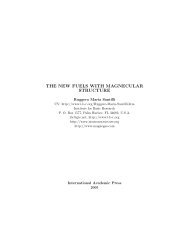Toroidal configuration of the orbit of the electron of the hydrogen ...
Toroidal configuration of the orbit of the electron of the hydrogen ...
Toroidal configuration of the orbit of the electron of the hydrogen ...
Create successful ePaper yourself
Turn your PDF publications into a flip-book with our unique Google optimized e-Paper software.
interest in <strong>the</strong>oretical and applicational plasmachemistry.Possible applications are in MagneGas technology, <strong>the</strong>oretical foundationsand exciting implications <strong>of</strong> which are developed by Santilli [2]. Werefer <strong>the</strong> reader to Ref. [2] for <strong>the</strong> recent studies, description, and applications<strong>of</strong> MagneGas technology and PlasmaArcFlow reactors. Remarkable experimentalresults, including Gas-Chromatographic Mass-Spectroscopic andInfraRed spectrum data <strong>of</strong> Santilli’s magnegas, clearly indicates <strong>the</strong> presence<strong>of</strong> unconventional chemical species <strong>of</strong> magnecules, which have not been identifiedas conventional molecules, and are supposed to be due to <strong>the</strong> specificbonding <strong>of</strong> a magnetic origin. The basic physical picture <strong>of</strong> <strong>the</strong> magneculesproposed by Santilli [2] is related to <strong>the</strong> toroidal <strong>orbit</strong>als <strong>of</strong> <strong>the</strong> <strong>electron</strong>s <strong>of</strong>atoms exposed to a very strong magnetic field. The results <strong>of</strong> <strong>the</strong> presentpaper demonstrate this physical picture on <strong>the</strong> basis <strong>of</strong> <strong>the</strong> Schrödinger equation.As <strong>the</strong> result <strong>of</strong> <strong>the</strong> action <strong>of</strong> very strong magnetic field, atoms attaingreat binding energy as compared to <strong>the</strong> case <strong>of</strong> zero magnetic field. Evenat intermediate B ≃ B 0 , <strong>the</strong> binding energy <strong>of</strong> atoms greatly deviates fromthat <strong>of</strong> zero-field case, and even lower field intensities may essentially affectchemical properties <strong>of</strong> molecules <strong>of</strong> heavy atoms. This enables creation <strong>of</strong>various o<strong>the</strong>r bound states in molecules, clusters and bulk matter [1, 2, 4].The paper by Lai [4], who focused on very strong magnetic fields, B ≫ B 0 ,motivated by <strong>the</strong> astrophysical applications, gives a good survey <strong>of</strong> <strong>the</strong> earlyand recent studies in this field, including those on <strong>the</strong> intermediate range,B ≃ B 0 , multi-<strong>electron</strong> atoms, and H 2 molecule. Much number <strong>of</strong> papersusing variational/numerical and/or analytical approaches to <strong>the</strong> problem <strong>of</strong>light and heavy atoms, ions, and H 2 molecule in strong magnetic field, havebeen published within <strong>the</strong> last six years (see, e.g., references in [4]). However,highly magnetized molecules <strong>of</strong> heavy atoms have not been systematicallyinvestigated. One <strong>of</strong> <strong>the</strong> surprising implications is that for some diatomicmolecules <strong>of</strong> heavy atoms, <strong>the</strong> molecular binding energy is predicted to beseveral times bigger than <strong>the</strong> ground state energy <strong>of</strong> individual atoms. [5]2 Landau levels <strong>of</strong> a single <strong>electron</strong>To estimate intensity <strong>of</strong> <strong>the</strong> magnetic field which causes a considerable deformation<strong>of</strong> <strong>the</strong> ground state <strong>electron</strong> <strong>orbit</strong> <strong>of</strong> <strong>the</strong> <strong>hydrogen</strong> atom, one can3














